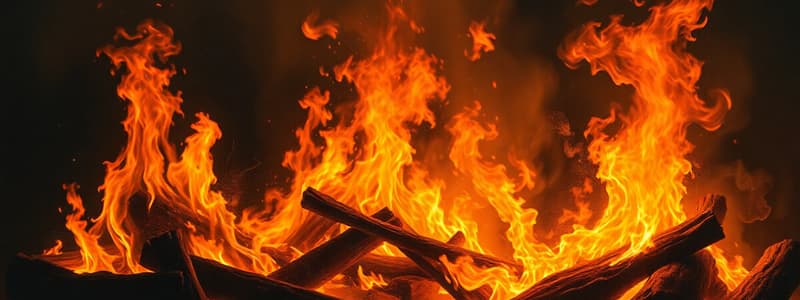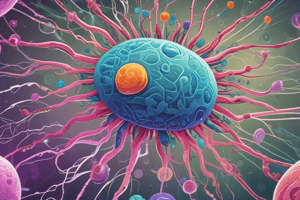Podcast
Questions and Answers
During which phase of fire progression does the intensity of burning increase, doubling with each 18°F rise in temperature?
During which phase of fire progression does the intensity of burning increase, doubling with each 18°F rise in temperature?
- Emergent Smoldering
- Free Burning (correct)
- Incipient
- Oxygen Regulated Smoldering
What condition primarily defines the Oxygen Regulated Smoldering phase of fire progression?
What condition primarily defines the Oxygen Regulated Smoldering phase of fire progression?
- An immediate explosion due to the mixture of gases reaching their ignition temperature.
- The ignition of all combustible materials in the room simultaneously.
- Depletion of oxygen, leading to flaming combustion ceasing and glowing combustion starting. (correct)
- A rapid increase in burning intensity due to high oxygen levels.
Which of the following best describes the 'Flashover' phenomenon in fire progression?
Which of the following best describes the 'Flashover' phenomenon in fire progression?
- The initial stage of a fire, where combustion is just beginning.
- The point at which all combustible materials in a room reach their ignition temperature and ignite almost simultaneously. (correct)
- The explosive resumption of free burning when oxygen is introduced into a smoldering room.
- The smoldering stage of a fire, characterized by heavy smoke and gases under pressure.
What is the primary hazard associated with the introduction of fresh oxygen into a room in the Oxygen Regulated Smoldering phase?
What is the primary hazard associated with the introduction of fresh oxygen into a room in the Oxygen Regulated Smoldering phase?
During which phase of fire progression are the products of combustion becoming increasingly pronounced?
During which phase of fire progression are the products of combustion becoming increasingly pronounced?
At approximately what temperature can the Oxygen Regulated Smoldering phase reach?
At approximately what temperature can the Oxygen Regulated Smoldering phase reach?
What is the ignition temperature of Carbon Monoxide (CO)?
What is the ignition temperature of Carbon Monoxide (CO)?
Which of the following is NOT a method of heat transfer during the Free Burning phase?
Which of the following is NOT a method of heat transfer during the Free Burning phase?
From the time in transcends a split second to several hours or even days. The time the description is about is the length of the phase of fire progression?
From the time in transcends a split second to several hours or even days. The time the description is about is the length of the phase of fire progression?
Before flashover occurs in the Free Burning stage, where is heat primarily convected?
Before flashover occurs in the Free Burning stage, where is heat primarily convected?
Flashcards
Incipient Phase of Fire
Incipient Phase of Fire
The initial stage of fire, lasting from a split second to hours or days, depending on fuel and ignition.
Emergent Smoldering Phase
Emergent Smoldering Phase
Combustion products become noticeable; marks the second stage of fire progression.
Free Burning Phase
Free Burning Phase
The rate and intensity of open burning increases in this phase of a fire.
Flashover
Flashover
Signup and view all the flashcards
Oxygen Regulated Smoldering
Oxygen Regulated Smoldering
Signup and view all the flashcards
Backdraft
Backdraft
Signup and view all the flashcards
Carbon Monoxide (CO)
Carbon Monoxide (CO)
Signup and view all the flashcards
Study Notes
4 Phases of Fire Progression
- Incipient is the earliest phase, lasting from a split second to hours or even days, contingent on fuel and ignition source.
- Emergent smoldering sees combustion byproducts become increasingly pronounced.
- Free burning involves an increase in the rate and intensity of open burning.
- For every 18°F increase in temperature, the fire intensity doubles.
- Heat is convected to the upper areas, with additional heat transfer via conduction and radiation.
- Flashover may occur when the ignition temperature of all items in the room is reached.
- Oxygen regulated smoldering represents the final phase, characterized by depleted oxygen levels.
- Flaming combustion ends, leading to glowing combustion with heavy smoke and pressurized gases.
- Temperatures can reach up to 1,000°F during oxygen-regulated smoldering.
- Exposure to fresh oxygen can cause resumption of free burning at an explosive rate, known as backdraft.
- CO is highly flammable, with an ignition temperature of 1128°F.
- Once the ignition temperature of CO is reached, the entire room of gas ignites, resulting in an explosion.
Studying That Suits You
Use AI to generate personalized quizzes and flashcards to suit your learning preferences.




